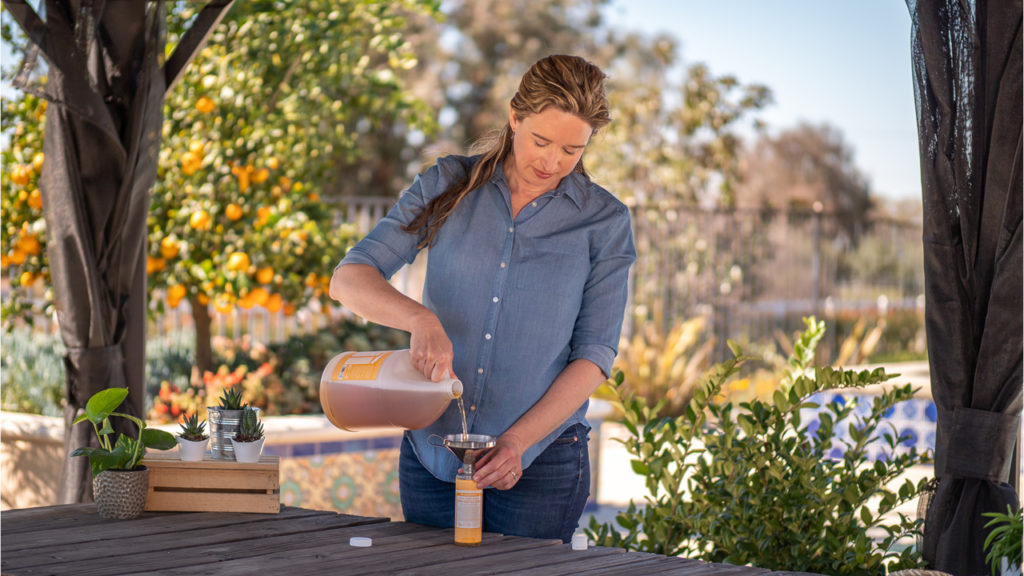
Sensing someone behind me as I was cleaning outdoor furniture, I spun around and found my sturdy little two-year-old son with both hands clasped around the trigger of the 409 and the nozzle planted firmly in his mouth.
“But Lisa,” I hear you say, “Why didn’t you know better? You’re a Bronner!”
You’re absolutely right. And as the shock, fear, guilt, anger flooded through me, my life changed course.
My call to Poison Control was fruitless because not even they could tell me the ingredients in 409, since ingredient disclosure wasn’t mandatory 15 years ago (and even now in 2022 is mandated in only a few states). With the advice echoing in my ears to “keep an eye on him and take him to the ER if problems arise,” my journey in green cleaning began.
After that near-miss, the top priority for me became products that cleaned effectively by the least intensive means, whose ingredients I understood, whose fumes and residues would not harm me or those around me, and even when misused by curious 2-year-olds, would not cause injury.
I did not know where this course would take me, but I certainly did not expect that as side benefits, I would save money and have a lot less cleaning cabinet clutter because, as I learned, a few products can clean it all. (If you’d like, here’s a peek inside my cleaning cabinet.) In almost all comparisons, these cleaners come out far ahead of conventional cleaners, and where they are pricier, there are still the safety and environmental benefits. For the comparisons below, I used the least expensive big box store brands I could find, or where store brands weren’t available, I used the least expensive name brands.
With the following four ingredients—Dr. Bronner’s Pure-Castile Soap and Sal Suds Biodegradable Cleaner, baking soda, and distilled white vinegar—I can clean my entire house. And with kids, dogs, cats, and miscellaneous wildlife in and out, I face a lot of different messes daily. Check out some of these numbers.
Dr. Bronner’s Castile Soap
Don’t underestimate the power of soap. A pure, well-crafted soap, free from fillers, foamers, and artificial fragrance, can clean any surface gently and thoroughly. Dr. Bronner’s Castile Soap is formulated first and foremost for optimal skin health. But because of its concentrated formula and lack of residue, it cleans all over the house from counters to floors to walls to laundry and more. Check out my Castile Uses and Dilutions Cheat Sheet for more details.
While full MSRP (manufacturer’s suggested retail price) on the Castile Soap may first strike the eye as high (and it can often be found for less than MSRP*), you must remember that it is concentrated. One bottle dilutes into many, many uses. I took the 32 oz. (946 mL) bottle, which is the most popular size, in order to demonstrate how on a per dilution basis, the Castile Soap is far more cost efficient than most conventional cleaners, not to mention the savings over cleaners sold as “natural” or “green”.
Plus, consider that in diluting a concentrate, you are getting many more uses out of one bottle, thereby reducing plastic usage – and your trips to the store. For further plastic reduction, look for stores and co-ops that allow you to refill your Dr. Bronner’s Castile Soap (Dr. Bronner’s continues to ramp up its refill program), or purchase the gallon size and refill your quart. Also, check out ways you can use the plastic-free Dr. Bronner’s Pure-Castile Bar Soap for all these same uses.
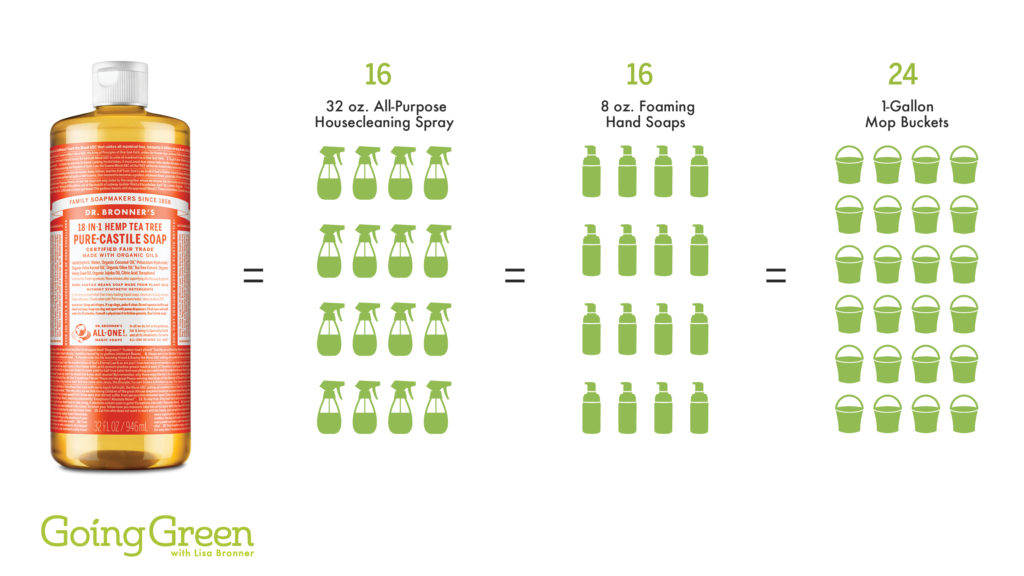
Dr. Bronner’s Liquid Pure-Castile Soap (Tea Tree shown) 32 oz. MSRP*: $18.49 USD
Makes 16 bottles of 32 oz. (1 L) All-Purpose Housecleaning Spray
- ¼ c. (60 mL) Soap in 1 qt. (1 L) water
- $1.16 per spray bottle
- Compares to $1.97 of store brand 32 oz. (1 L) conventional cleaning spray
Makes 16 bottles of 8 oz. (240 mL) foaming hand soap
- 1 part Soap to 3 parts water
- $1.16 per foaming pump refill
- Compares to $1.47 of store brand 8 oz. (240 mL) conventional foaming hand soap
Makes 24 buckets of 1-gallon mopping solution
- 3 Tbsp. (45 mL) Castile Soap in 1 gallon (4 L) water
- $.77 per gallon bucket
- Compares to $.44/gallon bucket of conventional floor cleaning soap
Dr. Bronner’s Sal Suds Biodegradable Cleaner
Sal Suds was developed by my dad Jim Bronner, Dr. Bronner’s son, in the 1980s as a tougher-on-stains cleaner that excelled in hard water conditions, while being exceptionally clean-rinsing and biodegradable. While Castile Soap holds the trophy for versatility across body and home, Sal Suds is my cleaning superpower around the house. Check out my Sal Suds Uses and Dilutions Cheat Sheet for how to put it to the most uses.
Sal Suds is more concentrated than the Castile Soap, so dilutions use less of it. This means you get many more uses per bottle. And since the MSRP is even lower than the Castile, that adds up to a lot of savings.
Using more than the recommended amount for dilutions is not harmful. Only wasteful. And may lead to an untimely bubble party. So don’t worry if you’ve been using too much, but check out how you’ll still get the same cleaning performance with less.
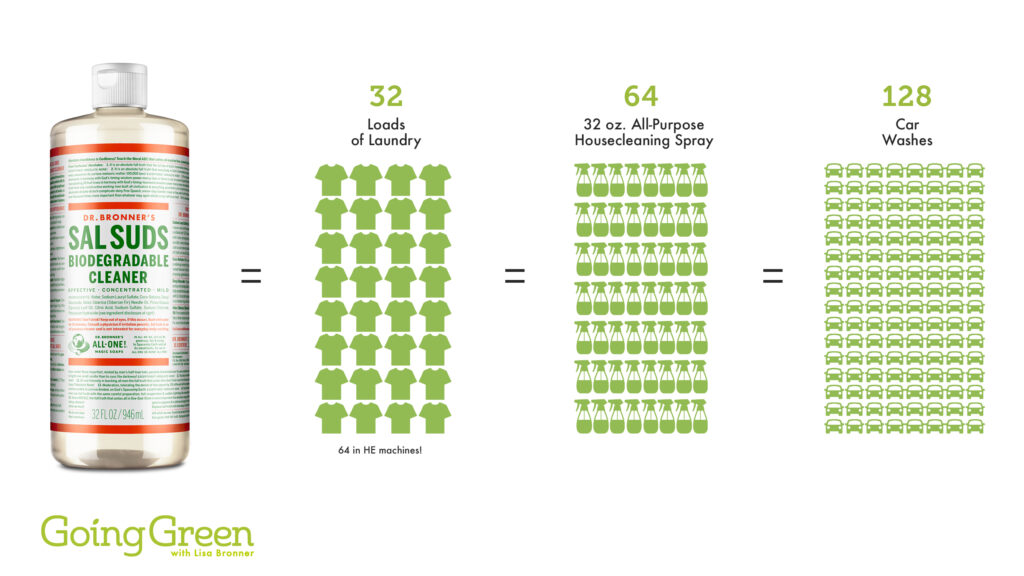
Dr. Bronner’s Sal Suds Biodegradable Cleaner 32 oz. MSRP*: $14.99 USD
Washes 32-64 loads of laundry
- 21 Tbsp. (15 mL) per load in HE machines; 2-3 Tbsp. (30-45 mL) per load for standard machines
- $.23 per HE load ($.47 per regular load)
- Compares to $.25 per load with popular “green” detergent or $.19 per load with popular conventional
Makes 64 bottles of 32 oz. (1 L) All-Purpose Housecleaning Spray
- 1 Tbsp. (15 mL) in 1 qt. (1 L) water
- $.23 per spray bottle
- Compares to $1.97 of store brand 32 oz. (1 L) conventional cleaning spray
Makes 128 buckets of car washing solution
- 1 tsp. (5 mL) in 1 gallon (4 L) of water
- $.12 per wash bucket
- Compares to $.04 per wash of least expensive car wash-concentrate from mass market
Baking soda
Baking soda and vinegar, below, are both bastions of the essential green cleaning cabinet. It’s chemical name is sodium bicarbonate, from which Brits get their name for it: bicarbonate of soda, or bicarb for short. It’s not news that this staple of kitchen pantries has myriad uses beyond the cooking spaces. Its odor-absorbing capabilities and gentle abrasiveness make it useful in scrubbing bathrooms, freshening carpets, and boosting laundry. It really punches up the clean when combined with either the Castile Soap or Sal Suds.
Baking soda is readily available in larger sizes than what you find in the baking aisle of grocery stores. Look for it in bags or boxes, and once you get into the swing of things, you will reach for this mild-mannered powder regularly. I buy it in 13-pound bags, but I used a 3.5 lb. bag here as more of an entry-level size.
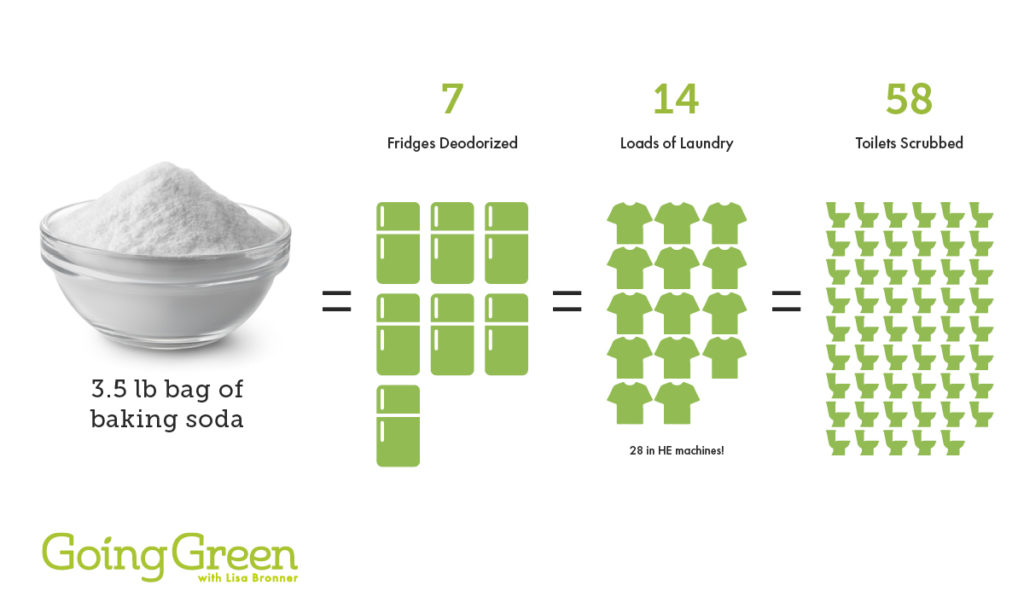
Baking Soda 3.5 lb. MSRP: $3.00 USD
Deodorizes 7 refrigerators
- 1 c. (240 mL) in a bowl, set in the back of the fridge
- $.50 per bowl (lasts roughly 3 months)
Boosts 14-28 loads of Laundry
- ½ c. (120 mL) added to large load in regular washer, ¼ c. (60 mL) for an HE machine
- $.21 per load in regular machine, $.11 in HE
Scrubs 58 Toilets
- 2 T. (30 mL) sprinkled on toilet bowl + spray with one of All-Purpose Sprays
- I keep the baking soda in an old spice shaker jar for this use
- $.05 per toilet bowl
Distilled white vinegar
Another resident of kitchen pantries has a place in the cleaning cabinet. Common kitchen vinegar is made from acetic acid diluted to 5% acidity, and is valuable as a degreaser, descaler, and deodorizer. It’s versatile as a glass cleaner, soap scum remover, water spot dissolver, and laundry booster. It is an excellent replacement for fabric softener.
A little more about vinegar. While it does have some antibacterial ability, it is ineffective against many common germs and should not be relied upon as the main cleaner. Cleaning vinegars, which bump up the acidity to as high as 30% are not any better at the uses I mention and their intensity can etch many household surfaces, including soft stone.
Lastly, and this is really important! Except in the case of the GIY Soft Scrub mentioned below, vinegar should not be mixed with soap. The two readily react with each other and form a gunk composed of loose fatty acids, which does not make a good cleaner. I know that I am going against boatloads of green cleaning recipes, but please trust the chemistry of this. Use soap and vinegar separately.
(And because I know someone will ask, while there is no chemical reaction when Sal Suds and vinegar are combined, vinegar decreases the cleaning ability of the Sal Suds.)
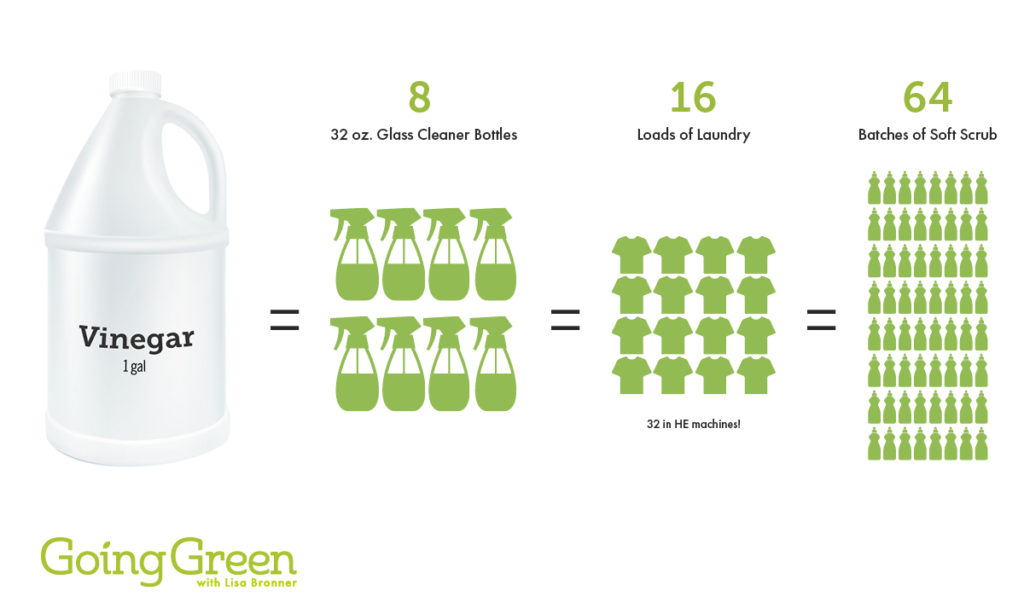
White Distilled Vinegar 1 gallon MSRP: $3.50 USD
Makes 8 bottles of 32 oz. (1 L) glass cleaner
- Combine equal parts vinegar and water
- $.44 per 32 oz. spray bottle
- Compares to $2.08 of store brand 32 oz. (1 L) conventional glass cleaner
Softens 16-32 loads of laundry when used as a fabric softener
- 1 c. (240 mL) in regular washer, ½ c. (120 mL) for an HE machine
- $.22 per load in regular machine, $.11 in HE
- Compares to $.08 per load of popular 50 oz. (1.5 L) conventional fabric softener
Makes 64 batches of Soft scrub
- See recipe for GIY Soft Scrub – a little more involved but great stuff
- $.54 of vinegar per batch
- Whole batch costs $6.38 with Castile, $2.48 with Sal Suds (based on MSRP)
- Compares to $3.34 per bottle of 36 oz. conventional soft scrub
In summary
When you take a look at all the many different single-purpose products that the above four can replace, you’ll see the advantage of using fewer, more versatile products. Think of all the separate bottles—I’m counting nine from only the uses I’ve discussed above (there are more)—that are pulling money from your wallet and cluttering up your cabinets. Now you’re down to just four.
My son, who now towers over me, is perfectly fine. There was no damage from that 409 moment, but what if I in my well-meaning desire to have a clean house had been using something far more caustic that day? What if it had been bleach? The irony is that we clean because we want to do the right thing—to keep a healthy environment around us, and to promote health and well-being in ourselves and those we love. The idea that, in doing so, I opened the door for harm to my son spurs me still to examine everything I use. With the mildness of these green cleaners, I feel perfectly comfortable having young kids use them, too. And the fact that green cleaners are cheaper and better for the environment is the best of all worlds.
Further reading
- 13 Essential Green Cleaning Ingredients
- Sal Suds or Castile Soap – Which to Use
- With Natural Cleaners Kids Can Clean Too
*Prices mentioned are current as of February 28, 2022. Although we control the price at which we sell to retailers and provide a suggested retail price (SRP), it is completely up to the retailer whether they want to make a lower or higher margin on our products. Pricing will always vary from retailer to retailer. The only retail prices we can enforce are the prices on our webstore.
Sal Suds cleaner shows >60% biodegradation after 28 days per ISO 14593.





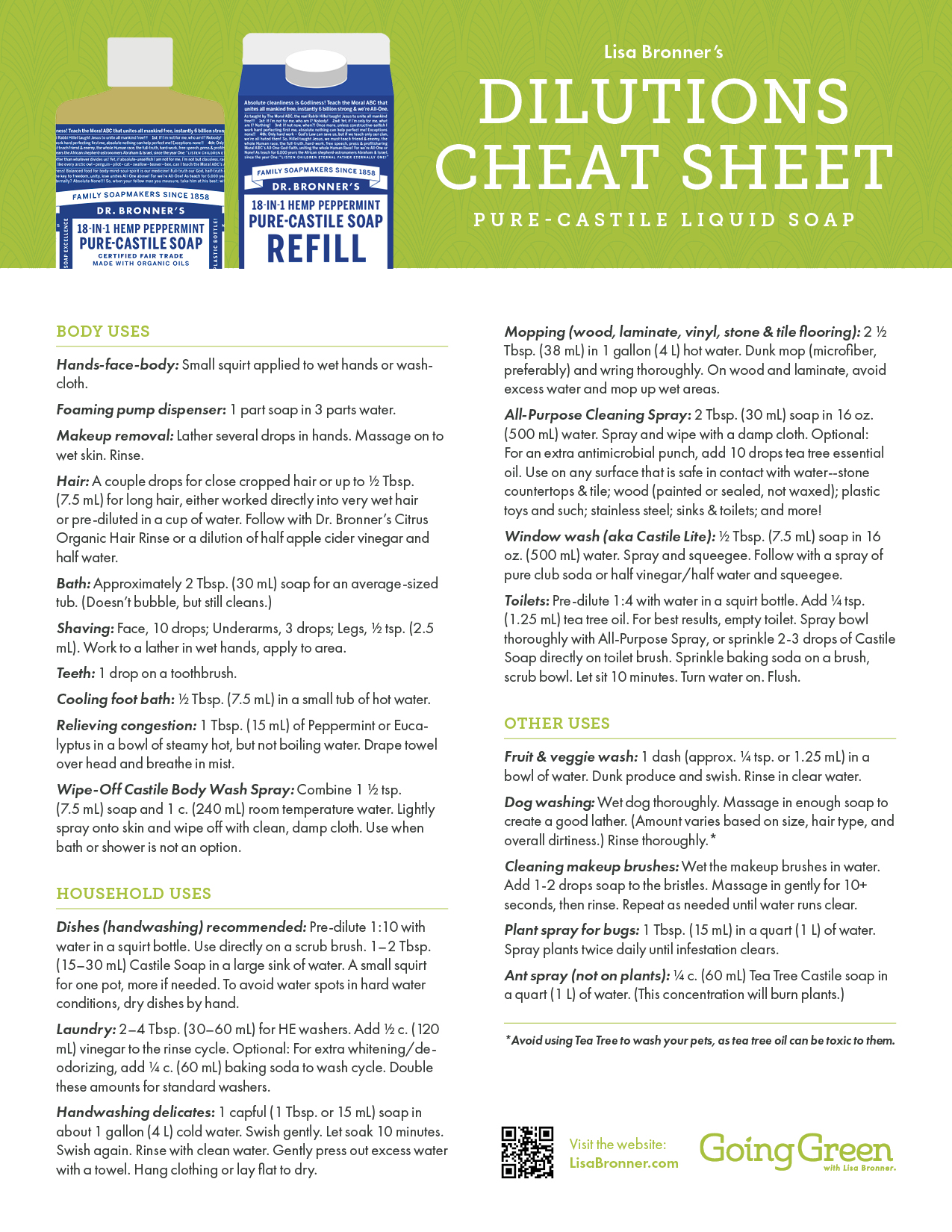
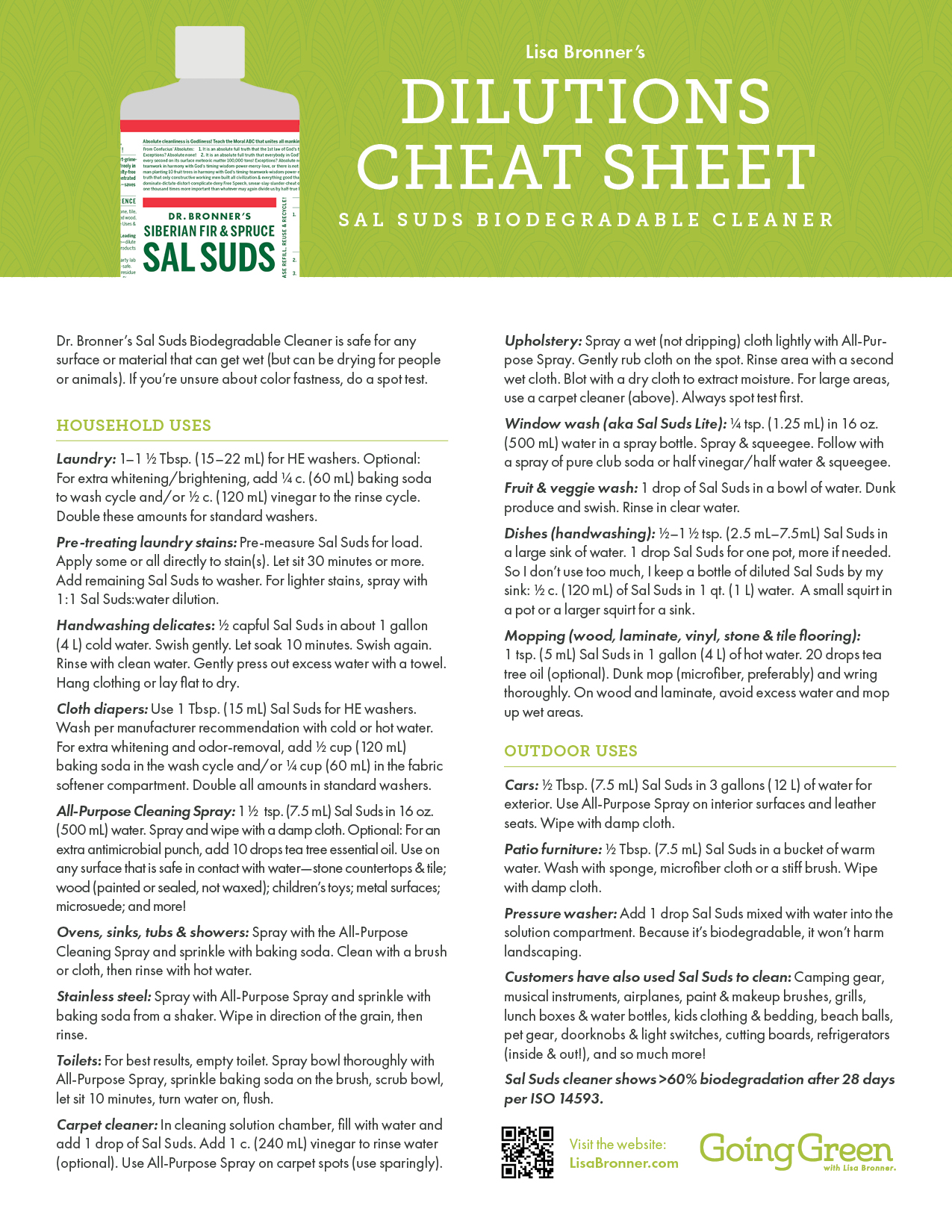
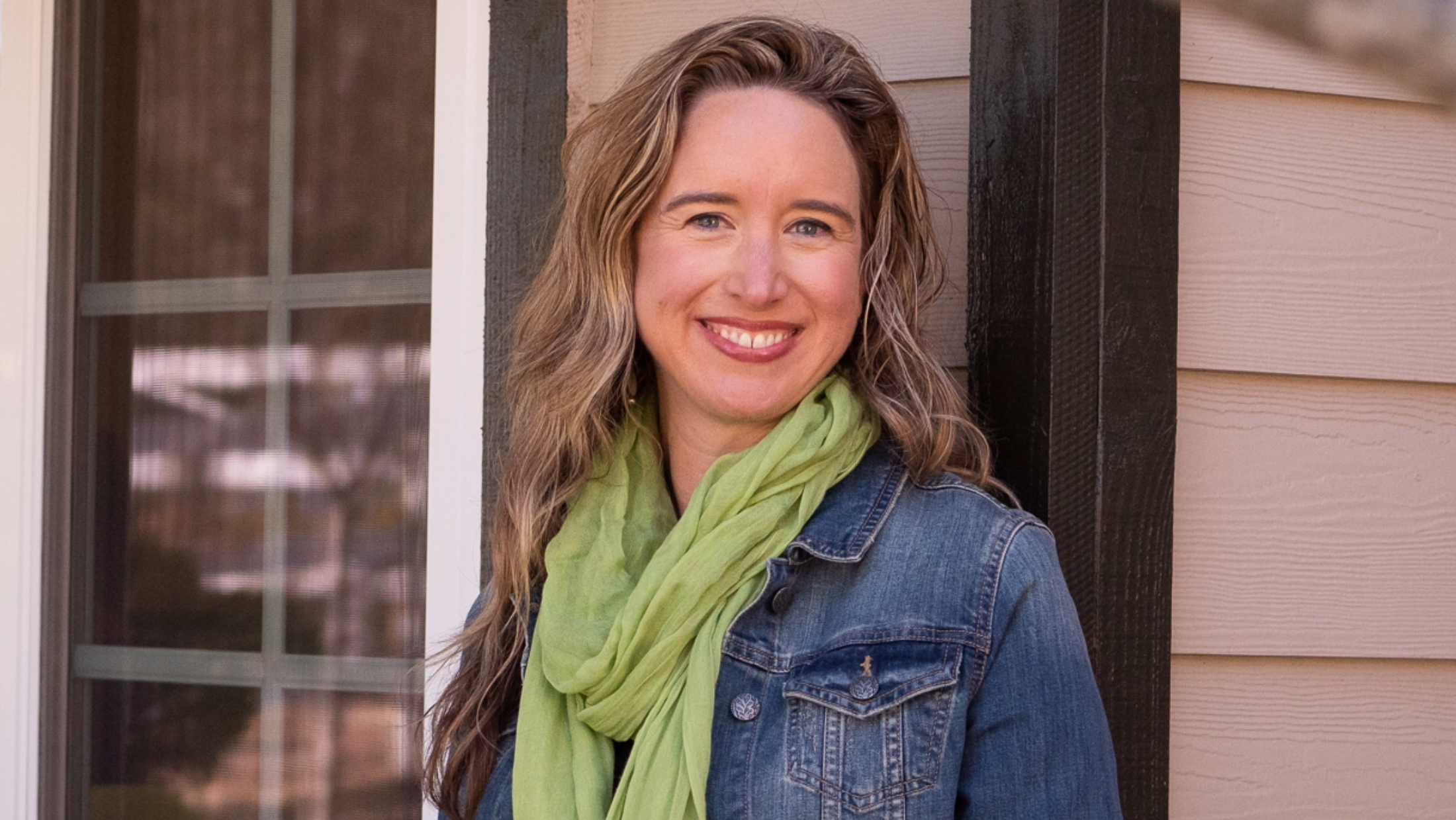

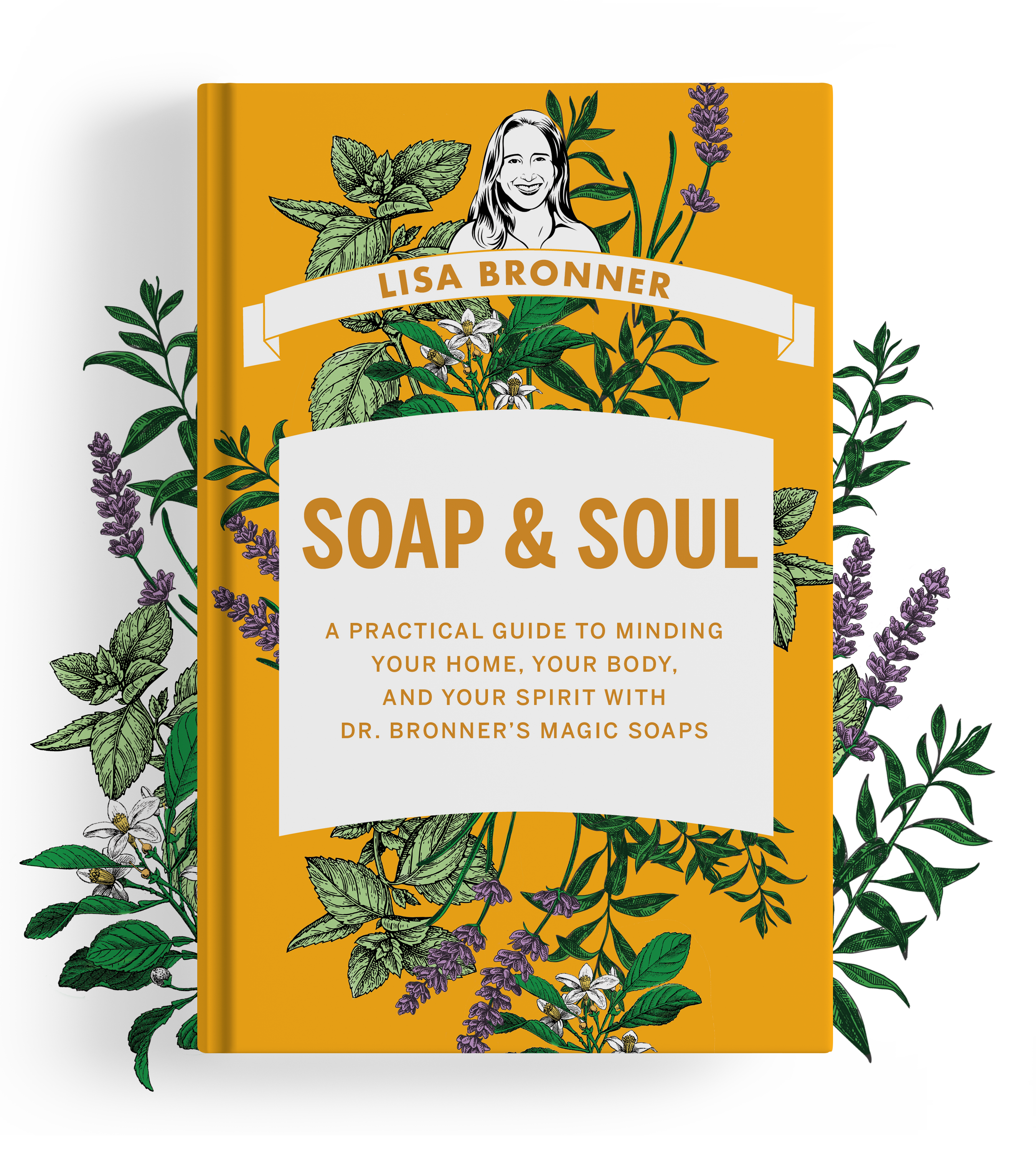
I use Sal suds in my front load HE washing machine.
What do you use to brighten up dingy whites?
I never use bleach and don’t like using peroxide.
I don’t know how safe oxiclean would be.
Hi Bonnie- I’m with you. I do not use bleach in any context. The risks are far too great and there are safer cleaners that are plenty effective. For whitening and brightening, add ¼ cup baking soda to a load. For more on laundry, check out my “Green Laundry” post at https://www.lisabronner.com/green-laundry-care-with-dr-bronners-video/.
I totally agree a book would be great and make great gifts for family and friends.
Agree!
Wow! I’m so glad to hear the content I share is helpful to you both!
Last summer I purchased a natural wood polish spray that I like. Ingredients: water, organic Castile soap, olive oil, grapefruit seed extract, lavender essential oil. Since the product was too pricey for my budget, can you come up with a similar recipe so that I can make my own? Thank you!
Hi there- When you combine soap and oil, the soap just binds to the oil and you lose the benefits of both. However, Karen Logan has two recipes in her excellent book “Clean House, Clean Planet”. For dusting: 2 tsp. olive oil, 20 drops or more of pure essential lemon oil, 1/4 c. white distilled vinegar. For deeper wood polish: 3/4 c. olive oil, 1/4 c. white distilled vinegar, 1/4 tsp. pure essential lemon oil. Shake well before each use as the oil and vinegar will separate. You can sub out the essential oils for the ones that you prefer. Check out her book for more details.
I love receiving your emails.
If you wrote a book with all your tips I’d be your first customer.
Hi Bonnie- Thanks for your support and kind words!
Hi Lisa ! This is a great invitation to try a greener cleaning.
I have been thinking of something I read at the beginning of the pandemic, do you know something about foaming soap not being as good as bar soap cleaning our hands? I usually use bar soap but I’m thinking of switching to foaming soap (dr bronners of course) but this info has stopped me for doing so. Hope you can help me clear my mind.
Hi Adrian- I recently came across a study that showed foaming soap and liquid soap remove germs equally well. The same would apply to foaming soap versus bar soap. Here’s the study, which involved some exceedingly brave participants!: http://www2.debgroup.com/sites/default/files/Water%20Savings%20Paper_1.pdf. You might also find my most recent article on Foaming Pump Dispensers of interest, https://www.lisabronner.com/making-a-foaming-hand-soap-with-castile-soap/